AUCTORES
Globalize your Research
Research Article | DOI: https://doi.org/10.31579/2768-0487/127
1Professor, Department of CSE, University of Information Technology & Sciences.
2Assistant Professor, Department of Public Health, Fareast International University.
*Corresponding Author: Monoarul Haque , Assistant Professor, Department of Public Health, Fareast International University.
Citation: Islam A, Haque M, (2024), A Block Chain Based Service in Maternity Health Care Sector in Bangladesh to Ensuring Holistic Health Services, Journal of Clinical and Laboratory Research, 7(3); DOI:10.31579/2768-0487/127
Copyright: © 2024, Monoarul Haque. This is an open-access article distributed under the terms of the Creative Commons Attribution License, which permits unrestricted use, distribution, and reproduction in any medium, provided the original author and source are credited.
Received: 05 February 2024 | Accepted: 20 February 2024 | Published: 26 February 2024
Keywords: maternity; blockchain based maternity; pregnancy; service; bangladesh
The purpose of this paper is to investigate the current paddy procurement system in Bangladesh and find out the consciousness of the farmers towards it. In this paper, quantitative research methodology was followed. To assess the consciousness the perception and satisfaction of farmers were measured. For the measurement, a survey was conducted on 210 farmers of three Upazilas using a pre-tested and close-ended questionnaire. Data analysis was done using SPSS software version 20. The study finds that about 67.6% of respondents are not happy with the current paddy procurement system. This study found that about 69.10% of respondents think there are the middle man in the current system of paddy procurement, about 94.30% of the respondent opined regarding the need for an improvement of the current system, 99.0% thinks about new paddy procurement system may be helpful. Moreover, these findings led to conclude that there is a huge scope of improvising the current paddy procurement system which will make the activities of the paddy procurement more transparent to all including the farmers. The study may significantly contribute to the policymaking in the paddy procurement system in Bangladesh and similar paddy procurement problems have been faced in many other countries in the world.
In recent years, Information Technology based services are increasing in many different sectors, even in the health sector in Bangladesh. As individuals transition from one life stage to the next there are some specific needs that are recognized by the researchers and designers. Therefore, many technologies were developed and adopted to meet those needs. For instance, learning tools designed for formal education, aiding both the teacher and the student. Notwithstanding all the trend and fast paced developments and research in various stages of life, but very few have investigated the first life stage that is when a woman becomes pregnant. There are serious risks associated with pregnancy and child birth as maternal and child health has been overlooked for a long time in the healthcare system. Lack of awareness, inadequate healthcare facilities, scarcity of skilled personnel, infrastructure, emergency facilities and access to medicine could be the probable reasons. According to the maternal mortality fact sheet published by World Health Organization (WHO) in 2015, Most of the women deaths are due to treatable complications related to pregnancy and childbirth arising from infections, severe blood loss, transmission of sexually transmitted diseases to newborns, high blood pressure, post-delivery complications and unsafe abortion and the number amounts to eight hundred deaths every day. This is mostly seen in lower socioeconomic conditions. Inequities in the availability of emergency obstetric care, care after delivery, newborn care, training to improve overall health, diet intake, lack of preparation for an emergency such as selected blood donor, transportation system, newborn feeding and care and hygiene behaviors are the types of antenatal and postnatal care are missing which may lead to neonatal deaths. These problems can be avoided by taking proper care during pregnancy and after the birth of the baby. For solving these several problems, maternity service is not enough. In this situation, an electronic device system is badly needed which will give a guideline in the daily life of a pregnant woman, change the whole experience of pregnancy and help to change the current perspective about pregnancy care and child care.
Application of Blockchain based Model
For analyzing this system and to understand the working procedure, we have to divide the whole system into three diagrams. They are:
Use Case Diagram (For admin)
Use case diagrams are usually referred to as behavior diagrams which are used to describe a set of actions of a system in collaboration with one or more external users.
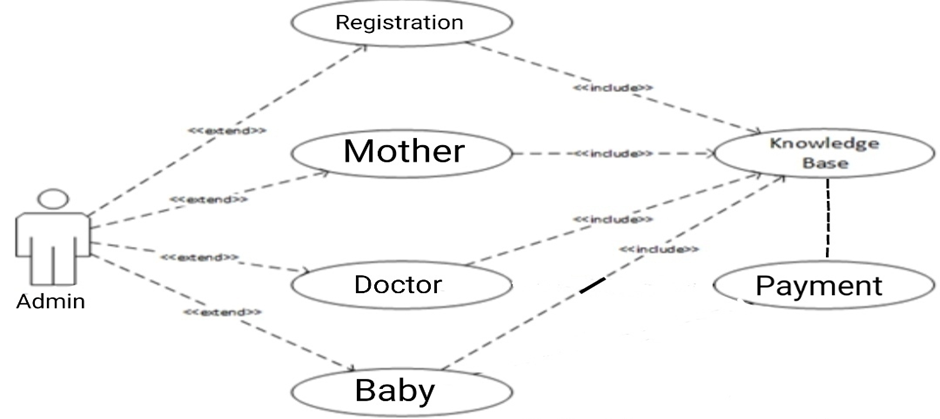
Figure 1: Users Activity Diagram.
The admin’s working procedure has shown with a use case diagram. In the use case diagram admin is the actor. An actor is a user that interacts with the system. In the use case diagram admin interacts with our system to describe a set of actions of use cases. Use cases represent a different set of actions that a user or an actor may need. Search user activates user list, update the main database, check notification, send a message is the use case of the system which will be needed by the admin.
User Activity Diagram (For mother)
An activity diagram visually presents a series of actions or flow of control in a system which is similar to flowchart or data flow chart. In our system, we use an activity diagram to show the data flow or working flow of the system. The activity has started at the initial point of the system. To access previously stored information about the mother the user has to login to the system. Then the activity or action state will start working with the action flow in the system.
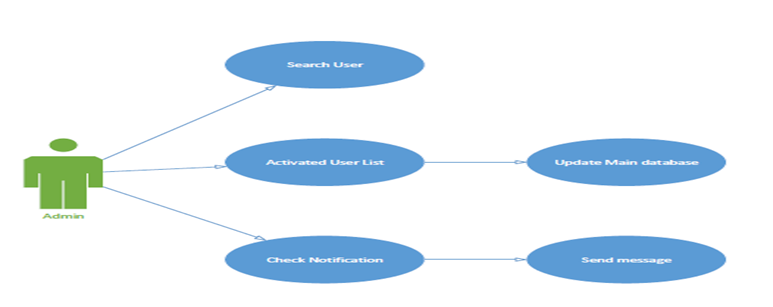
Figure 2: Use Case Diagram for admin.
Add first checkup information of a mother and then set reminder for the next checkup. At the next checkup date, if the user would complete the checkup and add new checkup info the system will take the next reminder for checkups. If the user wouldn’t complete the checkup, a message will come from the system for the expired date of checkup. And the system will not work until when the user has added the checkup info.
This system suggests nutritious food items for everyday in breakfast, brunch, lunch, snacks, dinner. For this the user has to select food for the relevant time and also select under which condition of health, then our system will process all the info and give them suggestion for food.
Vaccination process and Delivery section will work in the same way. First the user has to add the vaccination and set a reminder. Our system will give reminder for the next vaccination date if the previous vaccination has
completed. If not, then a message will come from the system for the expire date of vaccination. The Delivery section will be work in this way.
For any critical situation blood donor’s information will be stored in the blood donor list and also stored some blood donor group or page link of Facebook. The user needs to select donor and then call. If the user gets donors, then they have to confirm the system and if not, the system will take them to the user list again.
In transportation list, the system will be suggesting the nearest transport system by UBER, PATHAO (local apps-based transport company) or in case of an emergency there will be a list of ambulance service. The user needs to select the preferable transport system and then call. If the user gets transport, they have to confirm the system and if not, the system will take them to the transport list again.
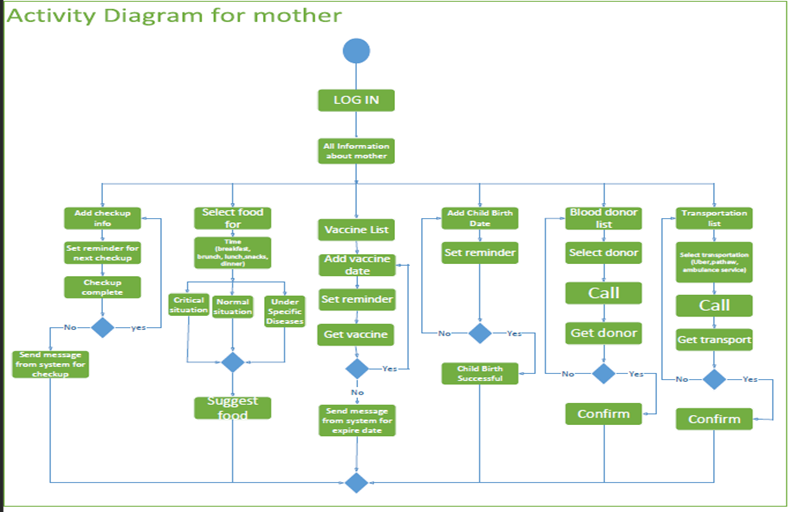
Figure 3: Use Case Diagram for Mother.
When all the processes of the user activity diagram (for mother) have completed the process will be connected with another user activity diagram (for baby) for further procedure of the system.
User Activity Diagram for baby
The user activity diagram for baby will start working when the baby is delivered. After the delivery of the baby the information will require all the
information about baby. When the user or the mother will give all the information related to the baby the information will require the completion of baby’s automatic birth registration. At this process, if the baby’s automatic birth registration system has done the system will allow the user to go to the next process. If a user wouldn’t complete the baby’s automatic birth registration, the system will not allow the user to proceed and send message to complete the automatic birth registration system.
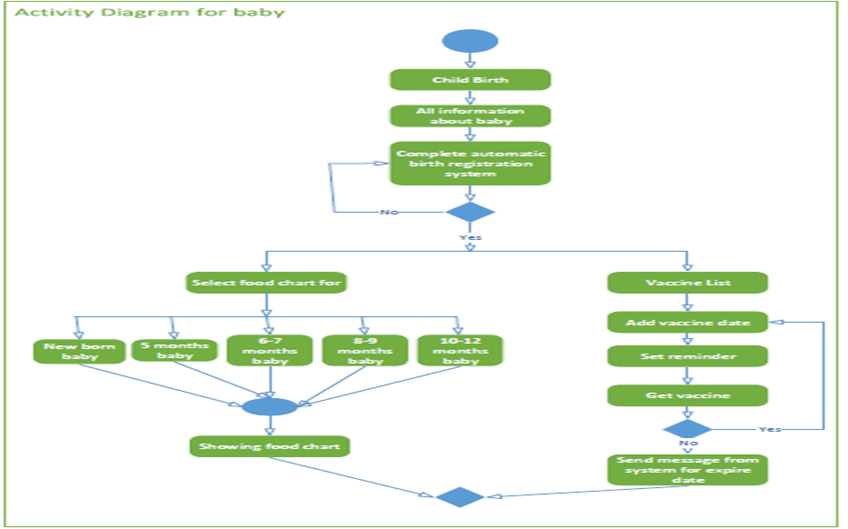
Figure 4: Use Case Diagram for Baby.
Now, when a baby’s automatic birth registration will be complete, the user can see the food chart for baby by selecting the food chart and then the system will show the food chart for the selected area. Now at this stage, the activity diagrams are done partially for this partial study of the system. The process will not be completed, the process will be open for further study and research and adding more functions in future.
Blockchain Based Activities
Proposed Blockchain Based solution of Current problems of Maternity Health care services in Bangladesh. After going through with the relevant work of others, a system architecture is proposed in this paper. It will give an overview of how a user obtains a block chain by registering to the system, how new nodes are added based on user’s permission along with shading light on the process of data sharing and finally explaining the distributed interoperable healthcare data sharing system.
Registration within the System and attain Block chain
The mother’s activities begin by registering to the system. Upon successful registration, the mother becomes the owner of her blockchain. The same process for the doctors and baby also. The genesis block is created after registration is completed. Figure 5 demonstrates the data flow of the registration process. Registration within the System and attain Block on successful registration, the other becomes the owner of her blockchain. The same process for the doctors and baby also. The genesis block is created after registration is completed mother information form. As this form's design is in line with FHIR format, it becomes interoperable to all who get access to the mother’s blockchain. To access their data, mothers would need to log into the system. Therefore, upon registration, mothers would receive their username and password on their email addresses and update them later on to maintain security. It should be noted that after inserting data in a blockchain, they become indisputable. Therefore, not all information of a mother can be added to a block chain. Otherwise, the need for maintaining a local database arises, which contradicts the idea of a distributed ledger system. To mitigate this problem and have all general information of mothers in the block chain, moving the storage system to the cloud is suggested, so that it can be accessible by any node connected to the blockchain, and the mother’s general information can be stored in the cloud database. Block chain ensures that sharing of medical information takes place without involving a trusted mediator. This helps to avoid performance degradation, and a single point of failure. Mothers will have command of their data by having the ability to permit trusted authorities like doctors to access and share their information. Medical history as a block chain data also assures integrity of data and it is also non-disclaim and distributed in decentralized manner. All data inputs are verifiably unchangeable and if there are any changes all the members of the mother network are notified. Moreover, any kind of unauthorized alterations can be easily spotted.
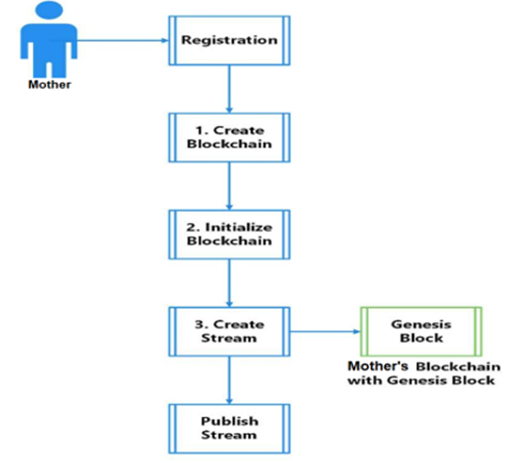
Figure 5: Mother registration process to Mother’s Blockchain.
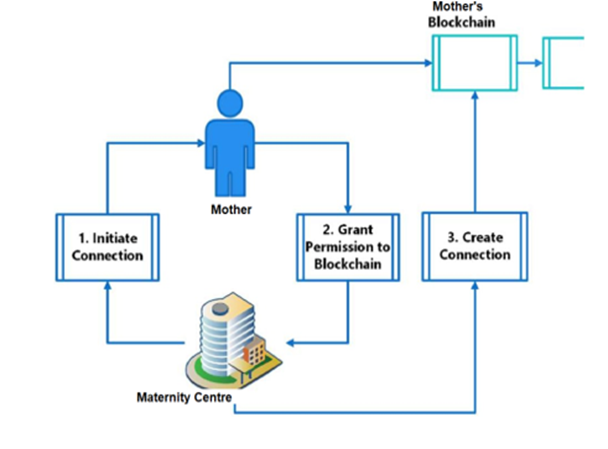
Figure 6: The process of connecting and creating genesis block.
Adding New Block to Block chain
When the user, in this case, the mother goes to a mother care centers to receive healthcare service, the mother care centers authority requests for accessing the mother’s blockchain. The mother care centers need to been listed or registered in the system in order to be eligible to request access to the mother’s data. The mother or any person, having authority to provide permission, can use a smart contract and Proof of Authority to grants access to the blockchain. After getting access the care center authority uses the smart contract to assign or give access to a doctor who can now view all the medical records. Consequently, the record is added to the blockchain as a new block. See the below figure 7 and 8.
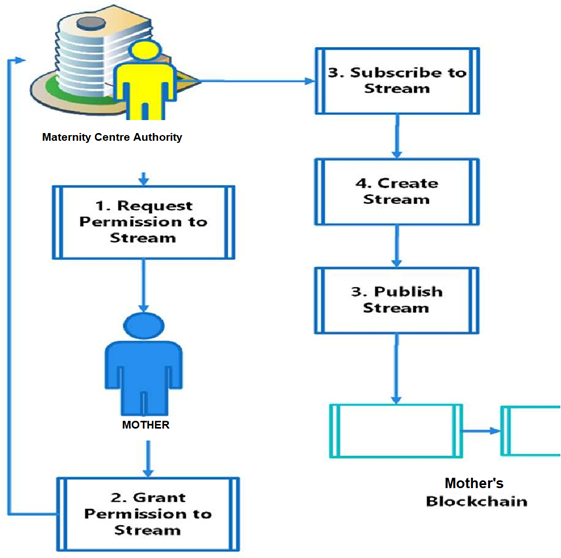
Figure 7: Addition of the new block in the blockchain with mother’s record.
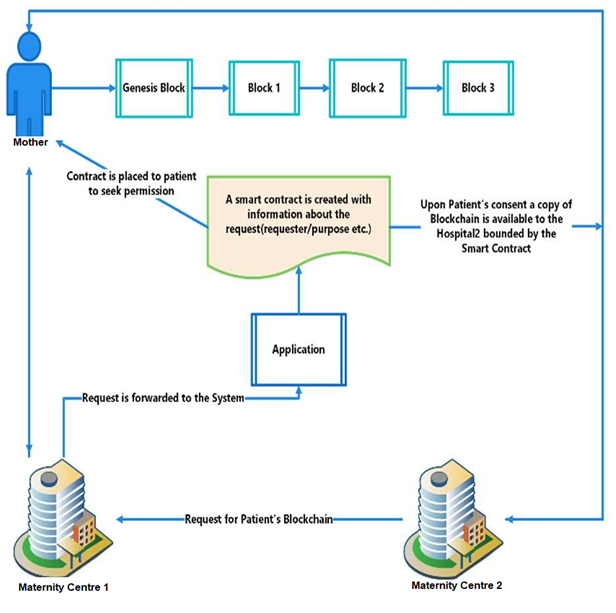
Figure 8: Sharing Blockchain Using Smart Contracts.
Sharing the Block chain
Mechanisms will be established for inter-operability and permission-based access control to the mothers’ blockchain, a technique to share the information among healthcare organizations to increase mother care and easing mother’s hurdles to provide necessary information whenever they visit any mother care centers is also proposed. Sharing mother information helps healthcare organizations to reduce readmissions, avoid medication errors, and even lessen the amount of duplicate pathological testing (Esposito et al., 2018). The goal of this framework is to enable the sharing of interoperable mother data among healthcare organizations in a secure way by keeping the permission granting instrument to mothers. Figure 8 explains the data sharing process, it is in assuming mother care centers-2 would like to access the mother’s record from mother care centers-1. In such a case, upon placing the request for access, mother care centers -1 has to forward the request to the mother or her nominated authority using a smart contract that will mention who is willing to access the blockchain for what purpose. If permission is granted, mother care centers 2willreceiveacopyofthemother’sblockchainas well. Once received, the later one will be able to access data according to the permission set by the first party during the grant process. The second party can only use data dictated by the rules set by the contract, which is reviewed by the mother or her authorized nominee.
Distributed System
Instead of keeping data in a centralized traditional database block chain works like a distributed ledgers using independent computers to record, share and synchronize transactions electronically. Blockchain sort out data blocks by chaining them together in an append-only mode (Azaria et al., 2016). The block chain, are stored by many authorities in the decentralized network. As it is the encrypted information in the blockchain, mothers’ privacy is secured when it is transferred between stake holders, and each of the stakeholders’ only access information to which they are specifically allowed by receiving permission granted by proper authorized entities. Each stakeholder can rely on the information he received to be accurate, because each hasan immutable chain that is identical to the other chains, and that they can perform audit to test its integrity (Li et al., 2018). In my proposed system, the built-in attributes of blockchain’s distributed ledger have been utilized, which will make sure that whenever a new block is added to the blockchain, the system will broadcast the update. Upon receiving the update, each copy of the block chain will have a newly added block making it a decentralized and distributed.
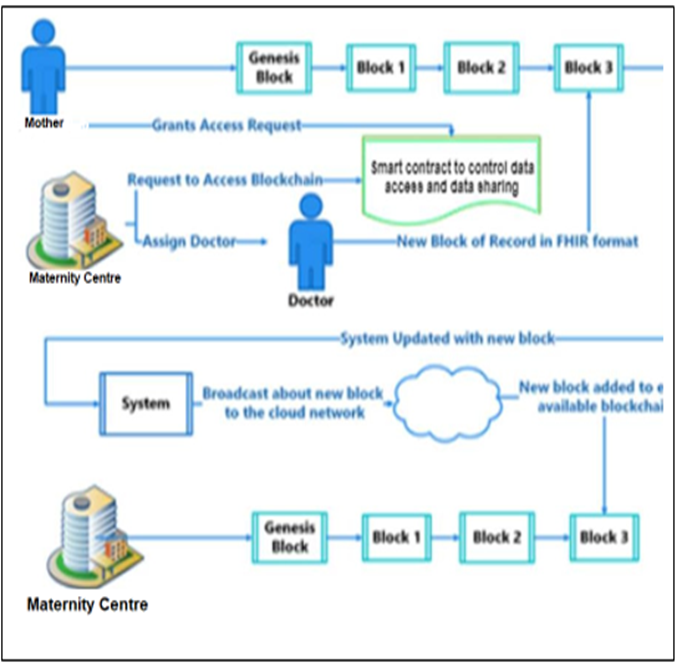
Figure 9: The Proposed distributed system.
Research limitations/implications – This research has several limitations that need to be taken into consideration. Here, the respondents generally believe that the people who come to them usually facilitate them. When they are informed that this is only for research work that time they were scared and are not ready to provide actual information.
The study concluded that the proposed system will be very beneficial and effective on the current circumstances of this country when the government and its different organs are struggling for reducing the mortality rate during pregnancy of the mother and the baby. This system will take care of mother with technology from the beginning stage of the pregnancy, create awareness and make a mother conscious about her checkup, nutrition, vaccine, delivery, transportation system.
Originality/value – A few studies on findings of the consciousness of the farmers towards the current paddy procurement system was found but it is apprehensive that a vast scope is there to work on a comprehensive level of farmers consciousness to improve the current paddy procurement system to make suitable and sustainable for the country and supportive to farmers which may help to make their life easier and comfortable.
Clearly Auctoresonline and particularly Psychology and Mental Health Care Journal is dedicated to improving health care services for individuals and populations. The editorial boards' ability to efficiently recognize and share the global importance of health literacy with a variety of stakeholders. Auctoresonline publishing platform can be used to facilitate of optimal client-based services and should be added to health care professionals' repertoire of evidence-based health care resources.

Journal of Clinical Cardiology and Cardiovascular Intervention The submission and review process was adequate. However I think that the publication total value should have been enlightened in early fases. Thank you for all.

Journal of Women Health Care and Issues By the present mail, I want to say thank to you and tour colleagues for facilitating my published article. Specially thank you for the peer review process, support from the editorial office. I appreciate positively the quality of your journal.
Journal of Clinical Research and Reports I would be very delighted to submit my testimonial regarding the reviewer board and the editorial office. The reviewer board were accurate and helpful regarding any modifications for my manuscript. And the editorial office were very helpful and supportive in contacting and monitoring with any update and offering help. It was my pleasure to contribute with your promising Journal and I am looking forward for more collaboration.

We would like to thank the Journal of Thoracic Disease and Cardiothoracic Surgery because of the services they provided us for our articles. The peer-review process was done in a very excellent time manner, and the opinions of the reviewers helped us to improve our manuscript further. The editorial office had an outstanding correspondence with us and guided us in many ways. During a hard time of the pandemic that is affecting every one of us tremendously, the editorial office helped us make everything easier for publishing scientific work. Hope for a more scientific relationship with your Journal.

The peer-review process which consisted high quality queries on the paper. I did answer six reviewers’ questions and comments before the paper was accepted. The support from the editorial office is excellent.

Journal of Neuroscience and Neurological Surgery. I had the experience of publishing a research article recently. The whole process was simple from submission to publication. The reviewers made specific and valuable recommendations and corrections that improved the quality of my publication. I strongly recommend this Journal.

Dr. Katarzyna Byczkowska My testimonial covering: "The peer review process is quick and effective. The support from the editorial office is very professional and friendly. Quality of the Clinical Cardiology and Cardiovascular Interventions is scientific and publishes ground-breaking research on cardiology that is useful for other professionals in the field.

Thank you most sincerely, with regard to the support you have given in relation to the reviewing process and the processing of my article entitled "Large Cell Neuroendocrine Carcinoma of The Prostate Gland: A Review and Update" for publication in your esteemed Journal, Journal of Cancer Research and Cellular Therapeutics". The editorial team has been very supportive.

Testimony of Journal of Clinical Otorhinolaryngology: work with your Reviews has been a educational and constructive experience. The editorial office were very helpful and supportive. It was a pleasure to contribute to your Journal.

Dr. Bernard Terkimbi Utoo, I am happy to publish my scientific work in Journal of Women Health Care and Issues (JWHCI). The manuscript submission was seamless and peer review process was top notch. I was amazed that 4 reviewers worked on the manuscript which made it a highly technical, standard and excellent quality paper. I appreciate the format and consideration for the APC as well as the speed of publication. It is my pleasure to continue with this scientific relationship with the esteem JWHCI.

This is an acknowledgment for peer reviewers, editorial board of Journal of Clinical Research and Reports. They show a lot of consideration for us as publishers for our research article “Evaluation of the different factors associated with side effects of COVID-19 vaccination on medical students, Mutah university, Al-Karak, Jordan”, in a very professional and easy way. This journal is one of outstanding medical journal.
Dear Hao Jiang, to Journal of Nutrition and Food Processing We greatly appreciate the efficient, professional and rapid processing of our paper by your team. If there is anything else we should do, please do not hesitate to let us know. On behalf of my co-authors, we would like to express our great appreciation to editor and reviewers.

As an author who has recently published in the journal "Brain and Neurological Disorders". I am delighted to provide a testimonial on the peer review process, editorial office support, and the overall quality of the journal. The peer review process at Brain and Neurological Disorders is rigorous and meticulous, ensuring that only high-quality, evidence-based research is published. The reviewers are experts in their fields, and their comments and suggestions were constructive and helped improve the quality of my manuscript. The review process was timely and efficient, with clear communication from the editorial office at each stage. The support from the editorial office was exceptional throughout the entire process. The editorial staff was responsive, professional, and always willing to help. They provided valuable guidance on formatting, structure, and ethical considerations, making the submission process seamless. Moreover, they kept me informed about the status of my manuscript and provided timely updates, which made the process less stressful. The journal Brain and Neurological Disorders is of the highest quality, with a strong focus on publishing cutting-edge research in the field of neurology. The articles published in this journal are well-researched, rigorously peer-reviewed, and written by experts in the field. The journal maintains high standards, ensuring that readers are provided with the most up-to-date and reliable information on brain and neurological disorders. In conclusion, I had a wonderful experience publishing in Brain and Neurological Disorders. The peer review process was thorough, the editorial office provided exceptional support, and the journal's quality is second to none. I would highly recommend this journal to any researcher working in the field of neurology and brain disorders.

Dear Agrippa Hilda, Journal of Neuroscience and Neurological Surgery, Editorial Coordinator, I trust this message finds you well. I want to extend my appreciation for considering my article for publication in your esteemed journal. I am pleased to provide a testimonial regarding the peer review process and the support received from your editorial office. The peer review process for my paper was carried out in a highly professional and thorough manner. The feedback and comments provided by the authors were constructive and very useful in improving the quality of the manuscript. This rigorous assessment process undoubtedly contributes to the high standards maintained by your journal.

International Journal of Clinical Case Reports and Reviews. I strongly recommend to consider submitting your work to this high-quality journal. The support and availability of the Editorial staff is outstanding and the review process was both efficient and rigorous.

Thank you very much for publishing my Research Article titled “Comparing Treatment Outcome Of Allergic Rhinitis Patients After Using Fluticasone Nasal Spray And Nasal Douching" in the Journal of Clinical Otorhinolaryngology. As Medical Professionals we are immensely benefited from study of various informative Articles and Papers published in this high quality Journal. I look forward to enriching my knowledge by regular study of the Journal and contribute my future work in the field of ENT through the Journal for use by the medical fraternity. The support from the Editorial office was excellent and very prompt. I also welcome the comments received from the readers of my Research Article.

Dear Erica Kelsey, Editorial Coordinator of Cancer Research and Cellular Therapeutics Our team is very satisfied with the processing of our paper by your journal. That was fast, efficient, rigorous, but without unnecessary complications. We appreciated the very short time between the submission of the paper and its publication on line on your site.

I am very glad to say that the peer review process is very successful and fast and support from the Editorial Office. Therefore, I would like to continue our scientific relationship for a long time. And I especially thank you for your kindly attention towards my article. Have a good day!

"We recently published an article entitled “Influence of beta-Cyclodextrins upon the Degradation of Carbofuran Derivatives under Alkaline Conditions" in the Journal of “Pesticides and Biofertilizers” to show that the cyclodextrins protect the carbamates increasing their half-life time in the presence of basic conditions This will be very helpful to understand carbofuran behaviour in the analytical, agro-environmental and food areas. We greatly appreciated the interaction with the editor and the editorial team; we were particularly well accompanied during the course of the revision process, since all various steps towards publication were short and without delay".

I would like to express my gratitude towards you process of article review and submission. I found this to be very fair and expedient. Your follow up has been excellent. I have many publications in national and international journal and your process has been one of the best so far. Keep up the great work.

We are grateful for this opportunity to provide a glowing recommendation to the Journal of Psychiatry and Psychotherapy. We found that the editorial team were very supportive, helpful, kept us abreast of timelines and over all very professional in nature. The peer review process was rigorous, efficient and constructive that really enhanced our article submission. The experience with this journal remains one of our best ever and we look forward to providing future submissions in the near future.

I am very pleased to serve as EBM of the journal, I hope many years of my experience in stem cells can help the journal from one way or another. As we know, stem cells hold great potential for regenerative medicine, which are mostly used to promote the repair response of diseased, dysfunctional or injured tissue using stem cells or their derivatives. I think Stem Cell Research and Therapeutics International is a great platform to publish and share the understanding towards the biology and translational or clinical application of stem cells.

I would like to give my testimony in the support I have got by the peer review process and to support the editorial office where they were of asset to support young author like me to be encouraged to publish their work in your respected journal and globalize and share knowledge across the globe. I really give my great gratitude to your journal and the peer review including the editorial office.

I am delighted to publish our manuscript entitled "A Perspective on Cocaine Induced Stroke - Its Mechanisms and Management" in the Journal of Neuroscience and Neurological Surgery. The peer review process, support from the editorial office, and quality of the journal are excellent. The manuscripts published are of high quality and of excellent scientific value. I recommend this journal very much to colleagues.

Dr.Tania Muñoz, My experience as researcher and author of a review article in The Journal Clinical Cardiology and Interventions has been very enriching and stimulating. The editorial team is excellent, performs its work with absolute responsibility and delivery. They are proactive, dynamic and receptive to all proposals. Supporting at all times the vast universe of authors who choose them as an option for publication. The team of review specialists, members of the editorial board, are brilliant professionals, with remarkable performance in medical research and scientific methodology. Together they form a frontline team that consolidates the JCCI as a magnificent option for the publication and review of high-level medical articles and broad collective interest. I am honored to be able to share my review article and open to receive all your comments.

“The peer review process of JPMHC is quick and effective. Authors are benefited by good and professional reviewers with huge experience in the field of psychology and mental health. The support from the editorial office is very professional. People to contact to are friendly and happy to help and assist any query authors might have. Quality of the Journal is scientific and publishes ground-breaking research on mental health that is useful for other professionals in the field”.

Dear editorial department: On behalf of our team, I hereby certify the reliability and superiority of the International Journal of Clinical Case Reports and Reviews in the peer review process, editorial support, and journal quality. Firstly, the peer review process of the International Journal of Clinical Case Reports and Reviews is rigorous, fair, transparent, fast, and of high quality. The editorial department invites experts from relevant fields as anonymous reviewers to review all submitted manuscripts. These experts have rich academic backgrounds and experience, and can accurately evaluate the academic quality, originality, and suitability of manuscripts. The editorial department is committed to ensuring the rigor of the peer review process, while also making every effort to ensure a fast review cycle to meet the needs of authors and the academic community. Secondly, the editorial team of the International Journal of Clinical Case Reports and Reviews is composed of a group of senior scholars and professionals with rich experience and professional knowledge in related fields. The editorial department is committed to assisting authors in improving their manuscripts, ensuring their academic accuracy, clarity, and completeness. Editors actively collaborate with authors, providing useful suggestions and feedback to promote the improvement and development of the manuscript. We believe that the support of the editorial department is one of the key factors in ensuring the quality of the journal. Finally, the International Journal of Clinical Case Reports and Reviews is renowned for its high- quality articles and strict academic standards. The editorial department is committed to publishing innovative and academically valuable research results to promote the development and progress of related fields. The International Journal of Clinical Case Reports and Reviews is reasonably priced and ensures excellent service and quality ratio, allowing authors to obtain high-level academic publishing opportunities in an affordable manner. I hereby solemnly declare that the International Journal of Clinical Case Reports and Reviews has a high level of credibility and superiority in terms of peer review process, editorial support, reasonable fees, and journal quality. Sincerely, Rui Tao.

Clinical Cardiology and Cardiovascular Interventions I testity the covering of the peer review process, support from the editorial office, and quality of the journal.

Clinical Cardiology and Cardiovascular Interventions, we deeply appreciate the interest shown in our work and its publication. It has been a true pleasure to collaborate with you. The peer review process, as well as the support provided by the editorial office, have been exceptional, and the quality of the journal is very high, which was a determining factor in our decision to publish with you.
The peer reviewers process is quick and effective, the supports from editorial office is excellent, the quality of journal is high. I would like to collabroate with Internatioanl journal of Clinical Case Reports and Reviews journal clinically in the future time.

Clinical Cardiology and Cardiovascular Interventions, I would like to express my sincerest gratitude for the trust placed in our team for the publication in your journal. It has been a true pleasure to collaborate with you on this project. I am pleased to inform you that both the peer review process and the attention from the editorial coordination have been excellent. Your team has worked with dedication and professionalism to ensure that your publication meets the highest standards of quality. We are confident that this collaboration will result in mutual success, and we are eager to see the fruits of this shared effort.

Dear Dr. Jessica Magne, Editorial Coordinator 0f Clinical Cardiology and Cardiovascular Interventions, I hope this message finds you well. I want to express my utmost gratitude for your excellent work and for the dedication and speed in the publication process of my article titled "Navigating Innovation: Qualitative Insights on Using Technology for Health Education in Acute Coronary Syndrome Patients." I am very satisfied with the peer review process, the support from the editorial office, and the quality of the journal. I hope we can maintain our scientific relationship in the long term.
Dear Monica Gissare, - Editorial Coordinator of Nutrition and Food Processing. ¨My testimony with you is truly professional, with a positive response regarding the follow-up of the article and its review, you took into account my qualities and the importance of the topic¨.

Dear Dr. Jessica Magne, Editorial Coordinator 0f Clinical Cardiology and Cardiovascular Interventions, The review process for the article “The Handling of Anti-aggregants and Anticoagulants in the Oncologic Heart Patient Submitted to Surgery” was extremely rigorous and detailed. From the initial submission to the final acceptance, the editorial team at the “Journal of Clinical Cardiology and Cardiovascular Interventions” demonstrated a high level of professionalism and dedication. The reviewers provided constructive and detailed feedback, which was essential for improving the quality of our work. Communication was always clear and efficient, ensuring that all our questions were promptly addressed. The quality of the “Journal of Clinical Cardiology and Cardiovascular Interventions” is undeniable. It is a peer-reviewed, open-access publication dedicated exclusively to disseminating high-quality research in the field of clinical cardiology and cardiovascular interventions. The journal's impact factor is currently under evaluation, and it is indexed in reputable databases, which further reinforces its credibility and relevance in the scientific field. I highly recommend this journal to researchers looking for a reputable platform to publish their studies.

Dear Editorial Coordinator of the Journal of Nutrition and Food Processing! "I would like to thank the Journal of Nutrition and Food Processing for including and publishing my article. The peer review process was very quick, movement and precise. The Editorial Board has done an extremely conscientious job with much help, valuable comments and advices. I find the journal very valuable from a professional point of view, thank you very much for allowing me to be part of it and I would like to participate in the future!”

Dealing with The Journal of Neurology and Neurological Surgery was very smooth and comprehensive. The office staff took time to address my needs and the response from editors and the office was prompt and fair. I certainly hope to publish with this journal again.Their professionalism is apparent and more than satisfactory. Susan Weiner

My Testimonial Covering as fellowing: Lin-Show Chin. The peer reviewers process is quick and effective, the supports from editorial office is excellent, the quality of journal is high. I would like to collabroate with Internatioanl journal of Clinical Case Reports and Reviews.

My experience publishing in Psychology and Mental Health Care was exceptional. The peer review process was rigorous and constructive, with reviewers providing valuable insights that helped enhance the quality of our work. The editorial team was highly supportive and responsive, making the submission process smooth and efficient. The journal's commitment to high standards and academic rigor makes it a respected platform for quality research. I am grateful for the opportunity to publish in such a reputable journal.
My experience publishing in International Journal of Clinical Case Reports and Reviews was exceptional. I Come forth to Provide a Testimonial Covering the Peer Review Process and the editorial office for the Professional and Impartial Evaluation of the Manuscript.

I would like to offer my testimony in the support. I have received through the peer review process and support the editorial office where they are to support young authors like me, encourage them to publish their work in your esteemed journals, and globalize and share knowledge globally. I really appreciate your journal, peer review, and editorial office.
Dear Agrippa Hilda- Editorial Coordinator of Journal of Neuroscience and Neurological Surgery, "The peer review process was very quick and of high quality, which can also be seen in the articles in the journal. The collaboration with the editorial office was very good."

I would like to express my sincere gratitude for the support and efficiency provided by the editorial office throughout the publication process of my article, “Delayed Vulvar Metastases from Rectal Carcinoma: A Case Report.” I greatly appreciate the assistance and guidance I received from your team, which made the entire process smooth and efficient. The peer review process was thorough and constructive, contributing to the overall quality of the final article. I am very grateful for the high level of professionalism and commitment shown by the editorial staff, and I look forward to maintaining a long-term collaboration with the International Journal of Clinical Case Reports and Reviews.
To Dear Erin Aust, I would like to express my heartfelt appreciation for the opportunity to have my work published in this esteemed journal. The entire publication process was smooth and well-organized, and I am extremely satisfied with the final result. The Editorial Team demonstrated the utmost professionalism, providing prompt and insightful feedback throughout the review process. Their clear communication and constructive suggestions were invaluable in enhancing my manuscript, and their meticulous attention to detail and dedication to quality are truly commendable. Additionally, the support from the Editorial Office was exceptional. From the initial submission to the final publication, I was guided through every step of the process with great care and professionalism. The team's responsiveness and assistance made the entire experience both easy and stress-free. I am also deeply impressed by the quality and reputation of the journal. It is an honor to have my research featured in such a respected publication, and I am confident that it will make a meaningful contribution to the field.

"I am grateful for the opportunity of contributing to [International Journal of Clinical Case Reports and Reviews] and for the rigorous review process that enhances the quality of research published in your esteemed journal. I sincerely appreciate the time and effort of your team who have dedicatedly helped me in improvising changes and modifying my manuscript. The insightful comments and constructive feedback provided have been invaluable in refining and strengthening my work".

I thank the ‘Journal of Clinical Research and Reports’ for accepting this article for publication. This is a rigorously peer reviewed journal which is on all major global scientific data bases. I note the review process was prompt, thorough and professionally critical. It gave us an insight into a number of important scientific/statistical issues. The review prompted us to review the relevant literature again and look at the limitations of the study. The peer reviewers were open, clear in the instructions and the editorial team was very prompt in their communication. This journal certainly publishes quality research articles. I would recommend the journal for any future publications.

Dear Jessica Magne, with gratitude for the joint work. Fast process of receiving and processing the submitted scientific materials in “Clinical Cardiology and Cardiovascular Interventions”. High level of competence of the editors with clear and correct recommendations and ideas for enriching the article.

We found the peer review process quick and positive in its input. The support from the editorial officer has been very agile, always with the intention of improving the article and taking into account our subsequent corrections.

My article, titled 'No Way Out of the Smartphone Epidemic Without Considering the Insights of Brain Research,' has been republished in the International Journal of Clinical Case Reports and Reviews. The review process was seamless and professional, with the editors being both friendly and supportive. I am deeply grateful for their efforts.
To Dear Erin Aust – Editorial Coordinator of Journal of General Medicine and Clinical Practice! I declare that I am absolutely satisfied with your work carried out with great competence in following the manuscript during the various stages from its receipt, during the revision process to the final acceptance for publication. Thank Prof. Elvira Farina

Dear Jessica, and the super professional team of the ‘Clinical Cardiology and Cardiovascular Interventions’ I am sincerely grateful to the coordinated work of the journal team for the no problem with the submission of my manuscript: “Cardiometabolic Disorders in A Pregnant Woman with Severe Preeclampsia on the Background of Morbid Obesity (Case Report).” The review process by 5 experts was fast, and the comments were professional, which made it more specific and academic, and the process of publication and presentation of the article was excellent. I recommend that my colleagues publish articles in this journal, and I am interested in further scientific cooperation. Sincerely and best wishes, Dr. Oleg Golyanovskiy.

Dear Ashley Rosa, Editorial Coordinator of the journal - Psychology and Mental Health Care. " The process of obtaining publication of my article in the Psychology and Mental Health Journal was positive in all areas. The peer review process resulted in a number of valuable comments, the editorial process was collaborative and timely, and the quality of this journal has been quickly noticed, resulting in alternative journals contacting me to publish with them." Warm regards, Susan Anne Smith, PhD. Australian Breastfeeding Association.

Dear Jessica Magne, Editorial Coordinator, Clinical Cardiology and Cardiovascular Interventions, Auctores Publishing LLC. I appreciate the journal (JCCI) editorial office support, the entire team leads were always ready to help, not only on technical front but also on thorough process. Also, I should thank dear reviewers’ attention to detail and creative approach to teach me and bring new insights by their comments. Surely, more discussions and introduction of other hemodynamic devices would provide better prevention and management of shock states. Your efforts and dedication in presenting educational materials in this journal are commendable. Best wishes from, Farahnaz Fallahian.
Dear Maria Emerson, Editorial Coordinator, International Journal of Clinical Case Reports and Reviews, Auctores Publishing LLC. I am delighted to have published our manuscript, "Acute Colonic Pseudo-Obstruction (ACPO): A rare but serious complication following caesarean section." I want to thank the editorial team, especially Maria Emerson, for their prompt review of the manuscript, quick responses to queries, and overall support. Yours sincerely Dr. Victor Olagundoye.

Dear Ashley Rosa, Editorial Coordinator, International Journal of Clinical Case Reports and Reviews. Many thanks for publishing this manuscript after I lost confidence the editors were most helpful, more than other journals Best wishes from, Susan Anne Smith, PhD. Australian Breastfeeding Association.

Dear Agrippa Hilda, Editorial Coordinator, Journal of Neuroscience and Neurological Surgery. The entire process including article submission, review, revision, and publication was extremely easy. The journal editor was prompt and helpful, and the reviewers contributed to the quality of the paper. Thank you so much! Eric Nussbaum, MD
Dr Hala Al Shaikh This is to acknowledge that the peer review process for the article ’ A Novel Gnrh1 Gene Mutation in Four Omani Male Siblings, Presentation and Management ’ sent to the International Journal of Clinical Case Reports and Reviews was quick and smooth. The editorial office was prompt with easy communication.

Dear Erin Aust, Editorial Coordinator, Journal of General Medicine and Clinical Practice. We are pleased to share our experience with the “Journal of General Medicine and Clinical Practice”, following the successful publication of our article. The peer review process was thorough and constructive, helping to improve the clarity and quality of the manuscript. We are especially thankful to Ms. Erin Aust, the Editorial Coordinator, for her prompt communication and continuous support throughout the process. Her professionalism ensured a smooth and efficient publication experience. The journal upholds high editorial standards, and we highly recommend it to fellow researchers seeking a credible platform for their work. Best wishes By, Dr. Rakhi Mishra.

Dear Jessica Magne, Editorial Coordinator, Clinical Cardiology and Cardiovascular Interventions, Auctores Publishing LLC. The peer review process of the journal of Clinical Cardiology and Cardiovascular Interventions was excellent and fast, as was the support of the editorial office and the quality of the journal. Kind regards Walter F. Riesen Prof. Dr. Dr. h.c. Walter F. Riesen.

Dear Ashley Rosa, Editorial Coordinator, International Journal of Clinical Case Reports and Reviews, Auctores Publishing LLC. Thank you for publishing our article, Exploring Clozapine's Efficacy in Managing Aggression: A Multiple Single-Case Study in Forensic Psychiatry in the international journal of clinical case reports and reviews. We found the peer review process very professional and efficient. The comments were constructive, and the whole process was efficient. On behalf of the co-authors, I would like to thank you for publishing this article. With regards, Dr. Jelle R. Lettinga.

Dear Clarissa Eric, Editorial Coordinator, Journal of Clinical Case Reports and Studies, I would like to express my deep admiration for the exceptional professionalism demonstrated by your journal. I am thoroughly impressed by the speed of the editorial process, the substantive and insightful reviews, and the meticulous preparation of the manuscript for publication. Additionally, I greatly appreciate the courteous and immediate responses from your editorial office to all my inquiries. Best Regards, Dariusz Ziora

Dear Chrystine Mejia, Editorial Coordinator, Journal of Neurodegeneration and Neurorehabilitation, Auctores Publishing LLC, We would like to thank the editorial team for the smooth and high-quality communication leading up to the publication of our article in the Journal of Neurodegeneration and Neurorehabilitation. The reviewers have extensive knowledge in the field, and their relevant questions helped to add value to our publication. Kind regards, Dr. Ravi Shrivastava.

Dear Clarissa Eric, Editorial Coordinator, Journal of Clinical Case Reports and Studies, Auctores Publishing LLC, USA Office: +1-(302)-520-2644. I would like to express my sincere appreciation for the efficient and professional handling of my case report by the ‘Journal of Clinical Case Reports and Studies’. The peer review process was not only fast but also highly constructive—the reviewers’ comments were clear, relevant, and greatly helped me improve the quality and clarity of my manuscript. I also received excellent support from the editorial office throughout the process. Communication was smooth and timely, and I felt well guided at every stage, from submission to publication. The overall quality and rigor of the journal are truly commendable. I am pleased to have published my work with Journal of Clinical Case Reports and Studies, and I look forward to future opportunities for collaboration. Sincerely, Aline Tollet, UCLouvain.

Dear Ms. Mayra Duenas, Editorial Coordinator, International Journal of Clinical Case Reports and Reviews. “The International Journal of Clinical Case Reports and Reviews represented the “ideal house” to share with the research community a first experience with the use of the Simeox device for speech rehabilitation. High scientific reputation and attractive website communication were first determinants for the selection of this Journal, and the following submission process exceeded expectations: fast but highly professional peer review, great support by the editorial office, elegant graphic layout. Exactly what a dynamic research team - also composed by allied professionals - needs!" From, Chiara Beccaluva, PT - Italy.

Dear Maria Emerson, Editorial Coordinator, we have deeply appreciated the professionalism demonstrated by the International Journal of Clinical Case Reports and Reviews. The reviewers have extensive knowledge of our field and have been very efficient and fast in supporting the process. I am really looking forward to further collaboration. Thanks. Best regards, Dr. Claudio Ligresti